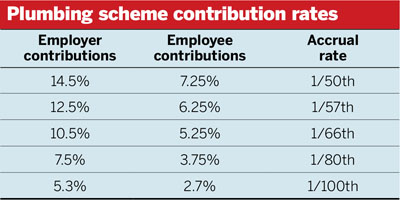The Plumbing and Mechanical Services Industry Pension Scheme will offer a lower contribution scale to new employers joining the career average scheme, to help it compete with defined contribution arrangements.
The scheme has presented itself as a risk-sharing alternative to DC arrangements for auto-enrolment, as the government encourages employers to share risks or provide some kind of guarantee for their members. 
The new rate will be the lowest of four contribution scales offered by the multi-employer scheme, set at 5.3 per cent for employers and 2.7 per cent for employees.
“What we decided to do was to introduce a contracted-in scale – and it’s still for defined benefit – to try and bring the contribution level down to... compete with the 8 per cent minimum that would be applied to DC,” said Stuart McDonald, pensions officer at the scheme.
It will be introduced from April 6 this year on a contracted-in basis and will have an accrual rate of 1/100th each year.
The £1.4bn scheme has around 470 participating employers – predominately smaller – who are due to stage auto-enrolment in 2016 and 2017.
The scheme previously offered four contribution levels to employers with an employer/employee ratio of two to one (see table).
These existing levels will remain on a contracted-out basis. The scheme’s board of directors will consider whether to make the new lower scale available to existing employers before contracting-out ends in 2016.
“We will have a good concept of how the industry is looking at it – if the directors felt the employers can’t afford the additional increases then it would [be decided] at that point to take into account everybody’s thoughts,” said McDonald
“It would be up to the directors whether they wish to bring the new scale to make it available for existing employers.”
Cutting costs
Auto-enrolment has pushed up costs for employers with DB schemes, said Hugh Nolan, chief actuary at JLT Employee Benefits.
“If you have the fact that only a small proportion of members [have] joined, it’s harder to afford that if you get 100 per cent rather than 40 or 50 per cent participation,” he said.
Some employers have set up nursery schemes for new starters, which have a lower employer contribution rate to lessen the burden.
Employees can be moved into the scheme with a higher contribution rate after a defined period of service, typically between two and five years. Employers could also eventually decide to close the more generous scheme to future accrual.
“As time passes you end up with fewer people in that older scheme and they work alongside people who work within a less generous scheme who get a bit fed up,” said Nolan.
However, in a time of lower pay increases and national insurance rebates, employers will need to consider how they communicate any changes made to the scheme, said James Patten, head of pension benefit design at Aon Hewitt.
“Employers need to think carefully about how they time that message,” said Patten.
It could be better to communicate any changes to the scheme in early 2015 rather than at the end of the year to allow them to absorb the news, he said.














